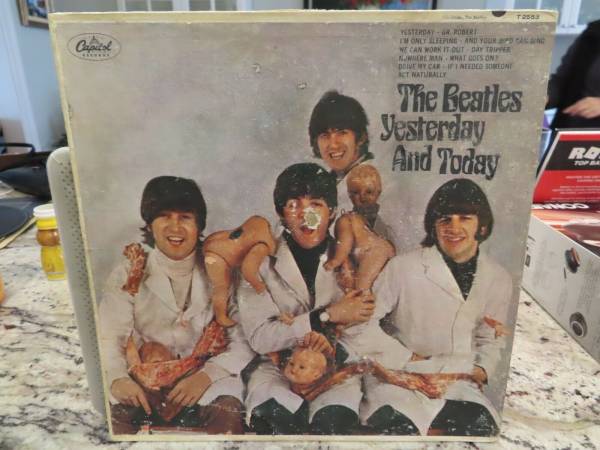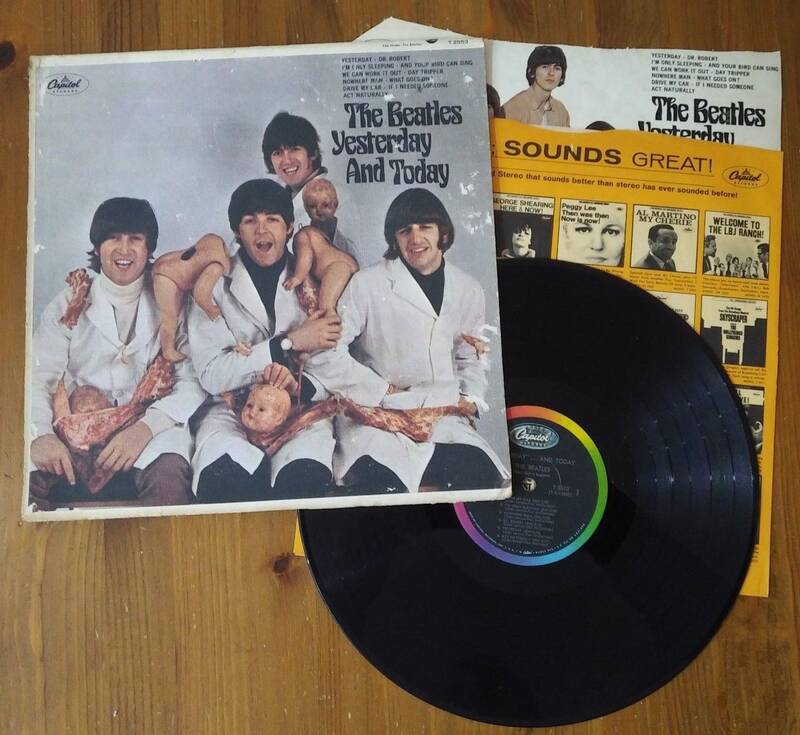The Beatles Yesterday And Today Lp Butcher Cover 2nd State Peel Authentic Scarce
This item have been sold for $ 299.99
Item Description
Yesterday and Today
1965 Yesterday and Today
1966 Revolver
1966
Yesterday and Today is a studio album by the Beatles, their ninth album released on Capitol Records and eleventh overall American release. It was originally issued only in the United States and Canada. In the 1970s it was issued in Japan. A later UK release on Compact Disc followed in 2014. The album is remembered primarily for the controversy surrounding its original cover image, the butcher cover featuring the band dressed in white smocks and covered with decapitated baby dolls and pieces of meat. The album s title is based on the song Yesterday . Early album cover proofsshow the word Yesterday in quotes. 5
Both Tim Riley 6 and American Songwriter journalist Jim Beviglia classified Yesterday and Today as a compilation album, 7 and MusicRadar said it was one in a series of hit-filled compilation albums that the American Capitol label sliced and diced from the Beatles original British albums. 8
Contents
hideMusic edit
Yesterday and Today included tracks from the Beatles two most recent British LPs which had not yet been included on American albums, plus three from their upcoming LP in the United Kingdom, plus two songs which were back-to-back on a single:
from the UK LP Help , the tracks Act Naturally and Yesterday earlier issued by Capitol as a single from the UK LP Rubber Soul, the tracks Nowhere Man and What Goes On also earlier issued by Capitol as a single , plus Drive My Car and If I Needed Someone. 9 both sides of the double A-side single Day Tripper / We Can Work It Out from the not-yet-released UK LP Revolver, the tracks I m Only Sleeping , Doctor Robert , and And Your Bird Can Sing, issued here in duophonic mixes see below . 10 These three tracks appeared in true stereo on tape releases and later vinyl releases. The true stereo mixes of I m Only Sleeping, Doctor Robert, and And Your Bird Can Sing that appear on Yesterday and Todayare different from the ones used for the subsequent release of Revolver in the UK, 11 and currently remain unreleased on compact disc.The hodge-podge nature in which Capitol Records compiled their albums irritated the group, who felt they had put a lot of work into the sequencing of the British albums. 12
Release and reception edit
Released on 20 June 1966, the Yesterday and Today album s controversial cover see section below marked the first time the Beatles judgement was criticised by the media and distributors. After advance copies were sent to disc jockeys and record reviewers, negative reaction to the cover photo was so strong Capitol recalled 750,000 copies from distributors to replace the cover. The total cost to Capitol to replace the cover and promotional materials was 250,000, wiping out their initial profit. 13 Nevertheless, the album reached 1 on the US Billboard charts by 30 July 1966 and certified gold soon after. It stayed at number one for five weeks. 14
Butcher cover edit
On 25 March 1966, photographer Robert Whitaker had the Beatles in the studio for a conceptual art piece titled A Somnambulant Adventure. For the shoot, Whitaker took a series of pictures of the group dressed in butcher smocks and draped with pieces of meat and body parts from plastic baby dolls. The group played along as they were tired of the usual photo shoots Lennon recalled the band having boredom and resentment at having to do another photo session and another Beatles thing 15 and the concept was compatible with their own black humour. 12 Although not originally intended as an album cover, the Beatles submitted photographs from the session for their promotional materials. According to a 2002 interview published in Mojo, former Capitol president Alan W. Livingston stated that it was Paul McCartney who pushed strongly for the photo s inclusion as the album cover, and that McCartney reportedly described it as our comment on the Vietnam war . 16 A photograph of the band smiling amid the mock carnage was used as promotional advertisements for the British release of the Paperback Writer single. A similar photograph from this shoot was used for the cover of the 11 June 1966 edition of the British music magazine Disc. 17
In the United States, Capitol Records printed approximately 750,000 copies of Yesterday and Today with the same photograph as Paperback Writer . 17 18 They were assembled in Capitol s four US plants situated in different cities: Los Angeles, California Scranton, Pennsylvania Winchester, Virginia and Jacksonville, Illinois. Numbers designating where the covers originated were printed near the RIAA symbol on the back for example, stereo copies from the Los Angeles plant are designated 5 and mono Los Angeles copies are marked 6 . Mono copies outnumbered stereo copies by about ten to one, making the stereo copies far more rare and valuable to collectors. A small fraction of the original covers were shipped to disc jockeys and reviewers as advance copies. Reaction was immediate, as Capitol received complaints from some dealers. The record was immediately recalled under orders from Capitol parent company EMI chairman Sir Joseph Lockwood 19 and all copies were ordered shipped back to the record label, leading to its rarity and popularity among collectors.
At the time, some of the Beatles defended the use of the Butcher photograph. Lennon said that it was as relevant as Vietnam and McCartney said that their critics were soft . 17 However, this opinion was not shared by all band members. George Harrison said in The Beatles Anthology that he thought the whole idea was gross, and I also thought it was stupid. Sometimes we all did stupid things thinking it was cool and hip when it was na ve and dumb and that was one of them. 12 In 2007 George Martin, the Beatles producer, recalled that the cover had been the cause of his first strong disagreement with the band. He added: I thought it was disgusting and in poor taste It suggested that they were madmen. Which they were, but not in that way. 20
Capitol initially ordered plant managers to destroy the covers, and the Jacksonville plant delivered most of its copies to a landfill. However, faced with so many jackets already printed, Capitol decided instead to paste a much more conventional cover over the old ones. The new cover, featuring a picture of the band posed around an open steamer trunk, had to be trimmed on the open end by about 3 mm 1/8 inch because the new sheet, known as a slick , was not placed exactly square on top of the original cover. Tens of thousands of these so-called Trunk covers were sent out. As word of this manoeuvre became known to the public, owners of the altered cover attempted, usually unsuccessfully, to peel off the pasted-over cover, hoping to reveal the original image hidden beneath. Eventually, the soaring value and desirability of unpasted-over Butcher covers spurred the development of intricate and complex techniques for peeling the Trunk cover off in such a way that only faint horizontal glue lines remained on the original cover.
Copies that have never had the white cover pasted onto them, known as first state covers, are ve




















